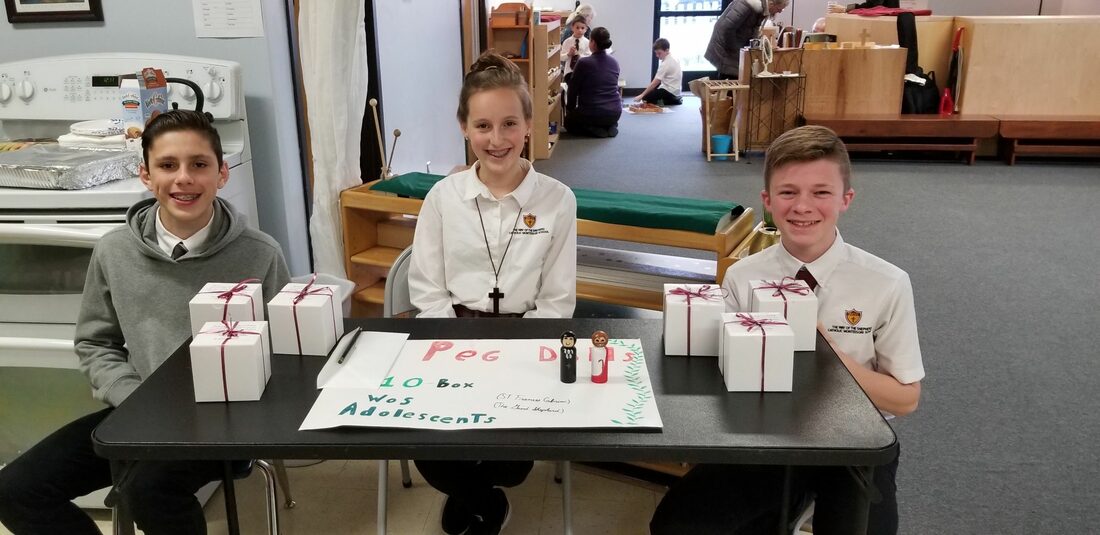|
I've been working with the adolescents to make a plan for their personal prayer time this summer. I pray that this is a prayer you can pray as a household as the school year closes and summer opens up:
Father, Creator of all, thank You for summer! Thank you for the warmth of the sun and the increased daylight. Thank You for the beauty I see all around me and for the opportunity to be outside and enjoy Your creation. Thank You for the increased time I have to be with my friends and family, and for the more casual pace of the summer season. Draw me closer to You this summer. Teach me how I can pray no matter where I am or what I am doing. Warm my soul with the awareness of Your presence and light my path with Your Word and Counsel. As I enjoy Your creation, create in me a pure heart and a hunger and a thirst for You. Author Unknown
0 Comments
The article below explains the 3rd plane of development, ages 12-18 and how Maria Montessori's Adolescent theory seeks to build up the "social man."
"At the time when we would expect an increase in responsibility, capability, academic performance, and independence, the adolescent appears to regress, and is less able to do what society expects of him than he was in elementary school. Consider too the typical educational setting for middle-school – hundreds of students, challenging classes with a great deal of homework, a different teacher for every subject, pressure to get “good grades,” and increased exposure to negative influences. Although Dr. Montessori’s work with adolescents is not as fully realized as her work with children in the first and second planes, her answer for the educational environment that would “aid the life” of the young adult in the third plane is just as radical and beautiful as the Casa dei Bambini was for the three year-old. Montessori sought to prepare the adolescent for adult life both socially and economically, in a safe, protected environment. She proposed that we “abandon the schoolroom and open the gate of life,” (Montessori, Education and Peace, “the Education of the Individual,” p. 111, Clio, 1999) creating a “center for work and study” in the quiet countryside where the whole of daily life would revolve around the changing needs of the adolescents. She believed that “If young people at a certain point are called upon to take an active part in the life of humanity, they must first feel that they have a great mission to accomplish and prepare themselves for it.” (Montessori, Education and Peace, “Fifth Lecture,” p.70, Clio, 1999) Montessori called these children the “Erdkinder” - children of the land. They would experience that same path that human civilizations began when people settled on the land and worked together cooperatively. They too would live together in a cooperative social group, and in living together would become responsible to each other and to themselves. Montessori wanted young people to be “producing, selling and working not in order to learn a trade, but because working means coming into contact with life, participating in the building of the supernature.”4 (Montessori, Education for Peace, “Fifth Lecture, p.70, Clio, 1999) Participating in real life, with real consequences, leads the young person to “valorization,” a term Montessori used to describe the internal and external validation of personality. For a healthy, confident entry into adult society, the young person must feel that he can contribute in a meaningful way to the community and see that value reflected back upon himself. This might come from watching his peers enjoy a meal he has helped prepare, mucking out the barn so that the cow has a clean place to stay, performing an original song in front of his friends, or selling all of the garlic flowers they brought to the farmers market. The young person realizes that he can do adult work in the adult world; he can “succeed in life by his own efforts and on his own merits, and at the same time it would put him in direct contact with the supreme reality of social life.” (Montessori, From Childhood to Adolescence, “Appendix A,” p. 64, Clio, 2003) See this link for the full article: static1.squarespace.com/static/519e5c43e4b036d1b98629c5/t/527d360ce4b098dc4f42703a/1383937548753/Four+Planes+of+Development+C38.pdf The adolescent community embarked on a new adventure in beginning their micro-economy with their Catholic peg dolls.
One student developed the proposal for the peg dolls and gathered the supplies needed, painted them, packaged them, and ensured they would be ready for sale. With A1 classmates assisting, the adolescents sold the peg dolls at Grandparent's day on North and South campus. At the end of the morning, the adolescents had accrued $130 dollars from their sales! Some of the proceeds will go to repaying their materials loan, but the remainder will go towards a fund of purchasing necessary items the adolescents desire for the A1 environment. These students are capable, resourceful, and ready to contribute to the community as active individuals in society and this project is just another example of their skill and readiness! |
Mrs. Goodwinand the Adolescent Classroom Students Archives
May 2019
Categories |

 RSS Feed
RSS Feed
